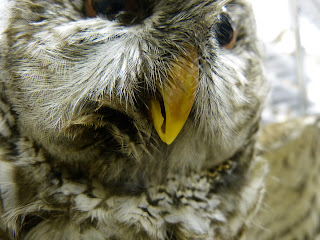Conservation Through Color
"Would it be best to order glass jars and and a bottle of ethanol now, or wait for another few weeks and finally splurge on that fancy air brush painting set that John had been nagging me to get all year?" This is a typical dilemma that I might find myself mulling over as the year draws to an end. I have just a sliver left of my collections budget, and want to make sure that my final purchases for 2018 are sensible. But why am I finding difficulty in deciding between fluid preservation supplies and...paint?
Many of the Museum's taxidermy mounts have actually required recoloring; our intent is that visitors aren't able to pick out which specimens those are. Behind the scenes, keratin-based tissues like feathers, beaks, and feet are usually painted or sealed as part of the conservation process. These tissues are most vulnerable to deterioration and color loss can be remarkable. At the onset of a taxidermy preparation session this summer, staff ogled at the striking sunset coloration of a barred owl's beak. However after just a few days of drying the color began to grow quite dull. I was horrified by the owl's fading beauty, but even more worrisome is the potential of displaying a specimen that isn't an accurate representative of the species.
 |
| Staff were fascinated by the beak of this barred owl during initial preparation. It has since been sealed to retain as much natural color as possible. |
This point is especially pertinent when considering birds. Plumage coloration is a well-documented means of communication between avian species, and some research even suggests that the coloration of beaks, legs, and other "bare parts" serve as color-based communications as well. Since color is this important to the social dynamics of these animals, museums as educational institutions must work to preserve that. As I look towards improving this institution's collections, an airbrush set becomes much more enticing.
Specialized paints and dyes are the norm in taxidermy recoloring these days. Unfortunately, standard drugstore products applied by hand have long been accepted supplies for specimen conservation. The results have often been cases of awkwardly yellow talons or a beak that resembles the aftermath of a pre-teen experimenting with lipstick. Acrylic paints and commercial dyes don't age well either, and I've occasionally ran into examples of flaking paint on birds in our own collection.
 |
| A golden eagle completed decades ago will require a cleaning and fresh coat of paint on both beak and talons to restore accuracy. |
Yet conservationists have made considerable attempts to rectify these issues, like the American Museum of Natural History which sought a better dye product for their mammal taxidermy. From their work they determine that a metal complex dye worked best for their faded mammals. The details of how the project team tested color combinations and artificially sped up time are fascinating, but in short their work provided a new standard for color application on taxidermy specimens.
 |
| Relatively new specimens of a white-fronted goose (above) and wood duck (below) had professional recoloring. |
Not every museum operates with a budget like the AMNH. The Cable Natural History Museum is a small organization, and simply purchasing an airbrush set for recoloring mounts could mean that I have to put other projects aside for some time. In the end I ordered jars, but plan on that airbrush set as the new year throws us into a new budget and renewed enthusiasm for the life of the collections.


